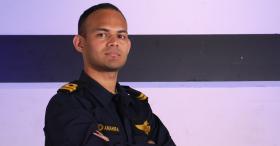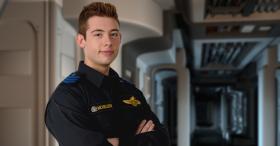Related
Lieutenant Neeraj Anahira is a tactical officer, coordinating the vessel’s tactical operations and serving as ‘tactical point’ on the bridge during combat situations, ensuring that the Conn has current information on the vessel
Crew are the technical specialists of the ISDC and receive applied technical training in their chosen professional fields right from the beginning of their careers.
Lt. Commander Rob Hewson is an engineering officer, part of a team of officers and crew that deliver Endeavour’s power, provide propulsion and monitor, maintain and repair the ship and its systems.
Given his training and experience he is responsible for managing the vessel’s power requirements and for monitoring the status of ship systems. This makes him a key engineering point of contact for the bridge.
What Would I be Doing?
Interested in Rob’s role as an engineering officer?
Depending on mission requirements you’ll co-ordinate with the bridge (or during alert conditions be on the bridge itself) to ensure necessary power allocation to implement mission requirements.
You’ll be drafting power allocation procedures for mission requirements and in combat situations you’ll need to manage that on the fly including sourcing emergency power or routing power around damaged areas of the vessel.
You’ll also monitor the status of vessel systems, providing diagnostic data if issues are detected and directing repair teams.
Becoming an Engineering Officer
Engineering officers are specialists and so are more focused on their area of expertise than line officers, although they will still be expected to manage teams.
As specialists, engineering officers can follow either an officer or warrant officer career track, usually depending on where they studied – at a military academy or a university.
Once you've completed training at the Academy you'll be able to gain more experience by joining simulator missions chosen from a growing library of tactical, exploratory, scientific and diplomatic scenarios.
First Steps
It starts by signing up as a cadet or candidate (depending on the career track chosen). It's obligation free and provides access to more information about the mission and Endeavour's technology as well as access to the Academy and assistance from instructors.
You’ll be asked to choose a ship system that interests you and begin training. An aspiring engineering officer would likely want to attain a Systems Engineer rating early to secure mission time.
When you successfully complete a training course you’ll be qualified (or ‘rated’) to operate that system on missions. You’ll also be promoted to Ensign or Junior Warrant Officer.
Gaining Experience
As a new ensign you’ll look to join a crew and undertake missions. Each mission completed gives you experience points (XP) which count towards promotion.
Missions offer opportunities for engineers to gain experience from the unique challenges and problems that emerge from each encounter.
You’ll also need to keep training, as additional ratings are also needed for promotion. Having both Systems Engineer and Engineer ratings would give broad mission coverage, for example. As specialists, engineering officers would typically choose additional ratings from within the branch.
Remember that in crisis situations everyone looks to engineers for options. This requires not just the system operation skills you’ll get from training but also a thorough knowledge of your system's operating principles and underlying theory.
Advancement
Stepping up as executive engineering officer (or “chief engineer”) requires a rank of at least Lieutenant-Commander. Logging XP as an instructor in addition to missions will help impress the promotion board.
There’s nothing to prevent an engineer attaining a command rating and taking the captain’s chair, but not all engineers are happy leaving the engine room. As a specialist an engineering officer is eligible to qualify for a master rating with the necessary XP and a significant technical contribution.
Not Sure?
Choosing your first rating doesn’t lock you into any particular career track or role. Choose something that interests you so that you can try simulator missions and get a feel for what you enjoy most.
There are no barriers to changing career tracks at any time. Your accumulated experience and ratings are fully transferable.





